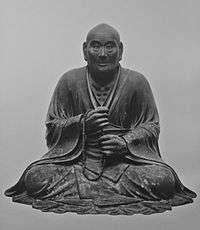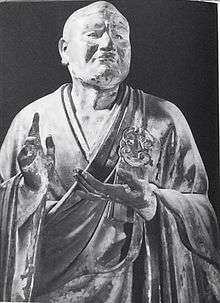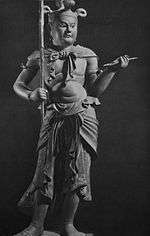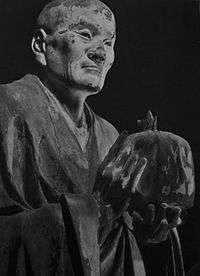Unkei

Unkei (運慶, around 1150[2]–1223) was a Japanese sculptor of the Kei school, which flourished in the Kamakura period. He specialized in statues of the Buddha and other important Buddhist figures. Unkei's early works are fairly traditional, similar in style to pieces by his father, Kōkei. However, the sculptures he produced for the Tōdai-ji in Nara show a flair for realism different from anything Japan had seen before. Today, Unkei is the best known of the Kei artists, and many art historians consider him its "most distinguished member".[3]
Career

Many extant works are said to be his, but the first that can be attributed to him with any certainty is a Dainichi Nyorai at Enjō-ji in Nara (1176).
Unkei was a devout Buddhist, and records from 1183 (Heian period end) show that he transcribed two copies of the Lotus Sutra with the aid of two calligrapher monks and a woman sponsor named Akomaro.[4] In the works' colophon, Unkei gives the names of all involved in performing the ritual obeisance (raihai) during the project's duration; the list includes Unkei himself and several members of his school. Unkei further records that he tallied the lines copied at the end of each day and then had devotees bow three times and chant the "august title" (likely daimoku) and the nembutsu for each one. In all, Unkei records that "During the copying, the above persons bowed fifty thousand times and [chanted] the nenbutsu one hundred thousand times, and the august title of the Lotus Sutra, one hundred thousand times."[5] In 1203, Unkei worked with Kaikei, two other master sculptors, and 16 assistants to create two guardian figures for the gates of the Nandaimon (Great South Gate) of Tōdai-ji in Nara. The statues, known as the Kongō Rikishi or Niō, are 26 feet tall.[6] The team finished the figures in 72 days using the yosegi technique of sculpting various pieces of wood separately and then combining them for the finished product.[7]
Sometime between 1208 and 1212, Unkei sculpted a figure of a Miroku Butsu (Sanskrit: Maitreya Buddha) at Tōdai-ji, along with several accompanied figures. These included two bodhisattva, the Shitennō (Four Heavenly Kings), and a pair of Indian rakan (Sanskrit: arhats) named Muchaku and Seshin. Only the Miroku Butsu and rakan still stand today.[8] After the completion of these works and others at the Kōfuku-ji, Unkei moved the Kei school's headquarters to Kyoto.
Unkei was chiefly acting in Kyoto and Nara. However, he traveled to Kamakura sometimes to do commissions for high-ranking samurai and administrators of the shogunate.[3]
A late 12th century sculpture of Dainichi Nyorai, attributed to Unkei, sold at auction at Christie's on March 18, 2008 for US$14.37 million, making it the most expensive Japanese art ever sold.[9][10]
Style
Unkei's early works are similar in style to those of his father, Kōkei, and contemporary, Kaikei. They are fairly traditional and show a certain delicateness.[6] The works Unkei sculpted around 1210 for the Hokuendō (North Octagonal Hall) at Tōdai-ji, on the other hand, are indicative of his fully developed style.[8] By this time, Unkei had begun to stress realism over tradition and solid, muscular forms over ephemeral, delicate ones.[6]
Unkei's Miroku Butsu is in the tradition of previous Buddha figures, including those of his father and ultimately Tori Busshi. Like the works of those sculptors, the Buddha is depicted as seated and backed by an intricate halo. However, Unkei's work features further strides toward realism. Crystal inlays cause the eyes to shine, and details are carved deeply and in new detail.[11] Furthermore, Unkei's work does not follow the canon of proportions established by Jōchō in the Heian period. Unkei's figure instead has a long torso that does not match the distance between the figures knees (a style used by sculptors for the preceding 150 years). Despite this, Unkei's Buddha does not look unbalanced or unwieldy. Rather, it is a lifelike Buddha who seems kind and empathic. In essence, Unkei created a new style of sculpture.[11]
This new realism is especially evident in Unkei's non-Buddha statuary. His Kongō Rikishi guardians stand contrapposto with dramatic stances. Their musculature, though anatomically incorrect, is well detailed,[6] making them appear to be in mid-movement.[7] These Niō reflect the warrior lifestyle and samurai ideals to which Unkei was exposed in Kamakura.[3]
Unkei's rakan figures, Mujaku and Seshin, take this realism to an even higher level, making the figures appear almost portrait-like.[12] Both statues sport priestly vestments that frame their bodies realistically. They stand life-size and alone and are fully sculpted in the round as if intended to be viewed from any angle. Mujaku is depicted as a thin man manipulating some sort of holy, cloth-wrapped object. He appears reserved and reflective. Seshin, in contrast, is depicted in mid conversation, gesturing and speaking, an extroverted counterweight to the solemn Mujaku.[11] The men are shown as specific people, not simply members of a stock type.[13]
Due to the collaborative nature of sculpture in this period, it is difficult to determine exactly how much of this innovation can be credited to Unkei personally.[6] Regardless of who was responsible, this new style was adopted by Unkei's followers and descendants, including his sons Tankei, Kōun, Kōben, and Kōshō, and carried on until the mid-Kamakura period.[6] Kōben and Kōshō especially would take Unkei's style to new extremes.[13]
 Seshin, Kōfuku-ji
Seshin, Kōfuku-ji Seitaka, Kongōbu-ji
Seitaka, Kongōbu-ji- Kimkara, Kongōbu-ji
.jpg)
See also
| Wikimedia Commons has media related to Unkei. |
Notes
- ↑ Mori Hisashi (1974). Sculpture of the Kamakura Period. Weatherhill. pp. 25–7. ISBN 9780834810174.
- ↑ Keizaburō, Mizuno (1972). Unkei to Kamakura chōkoku. Shogakkan. 150-155; Kuno, Takeshi and Taeda, Mikihiro (1974). Unkei no chōkoku. Heibonsha. 103-105.
- 1 2 3 Varley 94.
- ↑ Stone 135.
- ↑ Quoted in Stone 135.
- 1 2 3 4 5 6 Paine 110.
- 1 2 Mason 188.
- 1 2 Mason 189.
- ↑ http://most-expensive.net/japanese-art
- ↑ "A Highly Important Wood Sculpture of Dainichi Nyorai (Mahavairocana)." Christie's. Accessed 18 November 2008.
- 1 2 3 Mason 190.
- ↑ Noma 85.
- 1 2 Paine 112.
References
- Mason, Penelope (2005). History of Japanese Art. 2nd ed, rev. by Dinwiddie, Donald. Upper Saddle River, New Jersey: Pearson Education Inc.
- Noma, Seiroku (2003). The Arts of Japan: Ancient and Medieval. Kodansha International.
- Paine, Robert Treat, and Soper, Alexander (1981). The Art and Architecture of Japan. 3rd ed. Penguin Books Ltd.
- Stone, Jacqueline I. (1998). "Chanting the August Title of the Lotus Sutra: Daimoku: Practices in Classical and Medieval Japan". Re-visioning "Kamakura" Buddhism. University of Hawai'i Press.
- Varley, Paul (2000). Japanese Culture, 4th ed. University of Hawai'i Press.
